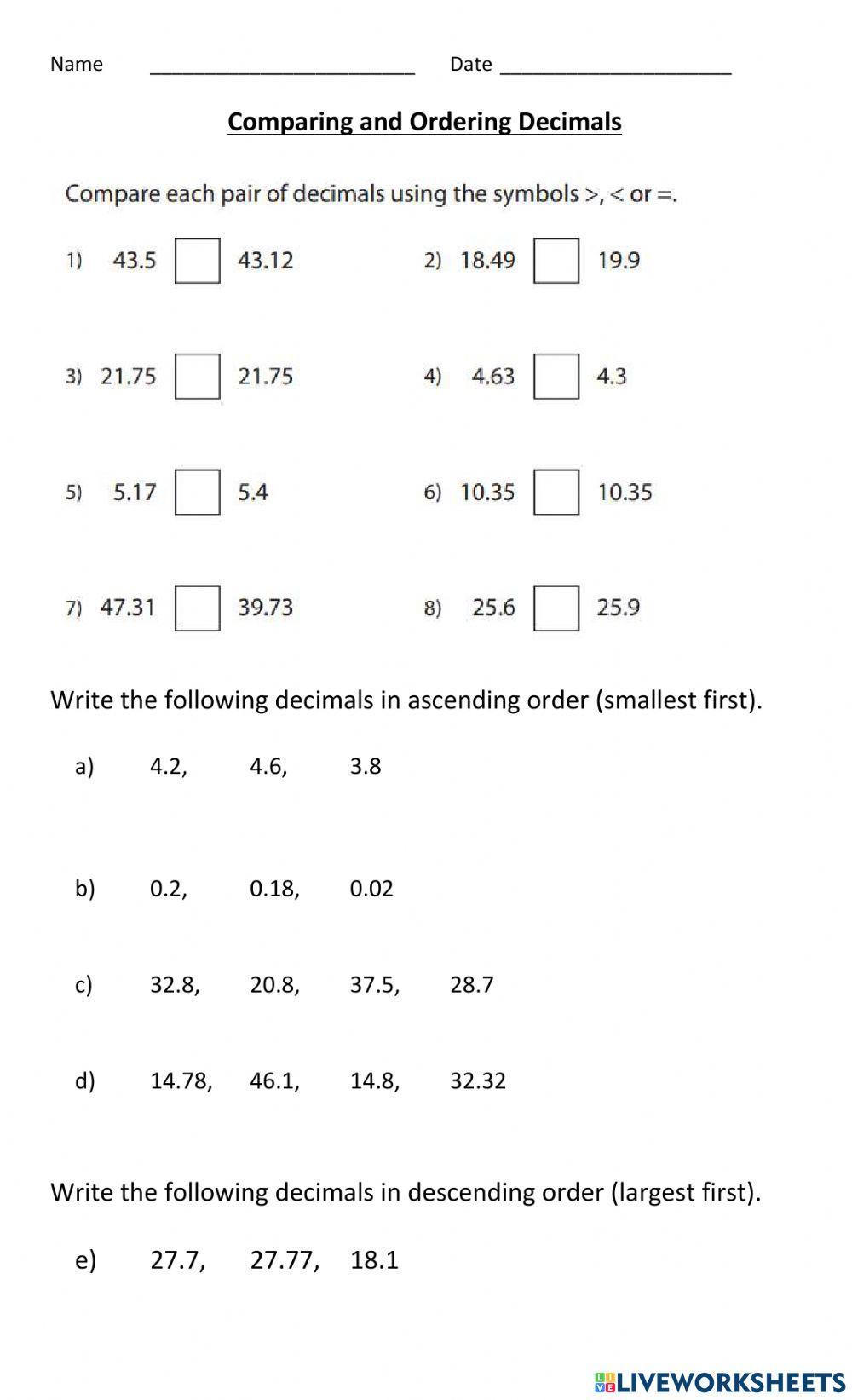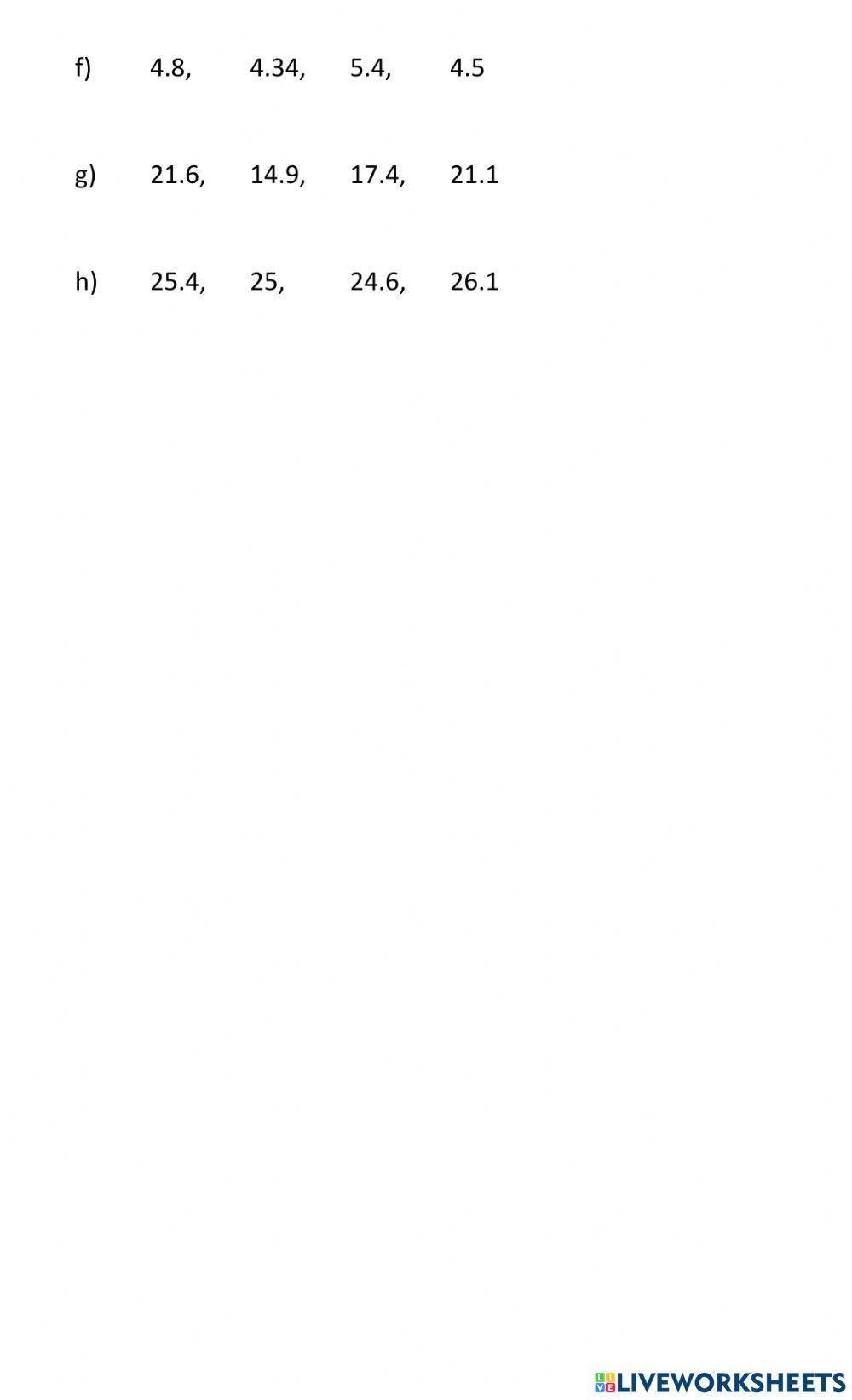Miembro desde hace
4 years 3 monthsEdad: 9-15
Level: 4-5
Idioma: English
(en)
ID: 710652
10/02/2021
Country code: BB
Country: Barbados
Tema principal: Decimals (2012940)
From worksheet author:
Compare and order the decimals.
Otros contenidos:
none
Worksheet description:
Objective Explanation:
The main objective of this worksheet is to help students practice comparing and ordering decimals. By engaging with the questions and exercises provided, students will enhance their skills in determining the relationships between different decimal numbers and arranging them in ascending or descending order.
Content Overview:
This worksheet focuses on decimals, a fundamental concept in mathematics. Students will compare pairs of decimals using the symbols >, <, or =, and then practice ordering decimals in both ascending and descending sequences. This will reinforce their understanding of place value and number relationships within the decimal system.
Language and Educational Level Context:
The worksheet is designed for students at an elementary or middle school level who are studying decimals in mathematics. The instructions are written in English, making it accessible to students with proficiency in the language. The questions are structured to align with the educational objectives of this level, providing appropriate challenges and opportunities for learning.
Subject Relevance:
Integrating decimals into the math curriculum is essential for students to develop strong foundational skills in numerical operations and problem-solving. Understanding how to compare and order decimals is crucial in real-life situations, such as working with money, measurements, or data analysis. This worksheet connects directly to the broader subject area of Math, emphasizing the practical applications of decimals in everyday scenarios.
Instructions:
The instructions prompt students to compare pairs of decimals by using symbols such as >, <, or =. For example, in question 1, students compare 43.5 and 43.12 to determine which is greater or if they are equal. This format is consistent throughout the worksheet, providing clear guidance on how to approach each comparison task.
Additionally, students are instructed to arrange decimals in ascending order (smallest first) and descending order (largest first). These exercises challenge students to apply their understanding of decimal values and place them in a meaningful sequence. For instance, in question d), students are asked to order decimals like 14.78, 46.1, 14.8, and 32.32, reinforcing their skills in comparing and organizing numbers effectively.
By following the instructions and engaging with the content presented in this worksheet, students will strengthen their proficiency in working with decimals and develop a deeper understanding of numerical relationships within the decimal system.
The main objective of this worksheet is to help students practice comparing and ordering decimals. By engaging with the questions and exercises provided, students will enhance their skills in determining the relationships between different decimal numbers and arranging them in ascending or descending order.
Content Overview:
This worksheet focuses on decimals, a fundamental concept in mathematics. Students will compare pairs of decimals using the symbols >, <, or =, and then practice ordering decimals in both ascending and descending sequences. This will reinforce their understanding of place value and number relationships within the decimal system.
Language and Educational Level Context:
The worksheet is designed for students at an elementary or middle school level who are studying decimals in mathematics. The instructions are written in English, making it accessible to students with proficiency in the language. The questions are structured to align with the educational objectives of this level, providing appropriate challenges and opportunities for learning.
Subject Relevance:
Integrating decimals into the math curriculum is essential for students to develop strong foundational skills in numerical operations and problem-solving. Understanding how to compare and order decimals is crucial in real-life situations, such as working with money, measurements, or data analysis. This worksheet connects directly to the broader subject area of Math, emphasizing the practical applications of decimals in everyday scenarios.
Instructions:
The instructions prompt students to compare pairs of decimals by using symbols such as >, <, or =. For example, in question 1, students compare 43.5 and 43.12 to determine which is greater or if they are equal. This format is consistent throughout the worksheet, providing clear guidance on how to approach each comparison task.
Additionally, students are instructed to arrange decimals in ascending order (smallest first) and descending order (largest first). These exercises challenge students to apply their understanding of decimal values and place them in a meaningful sequence. For instance, in question d), students are asked to order decimals like 14.78, 46.1, 14.8, and 32.32, reinforcing their skills in comparing and organizing numbers effectively.
By following the instructions and engaging with the content presented in this worksheet, students will strengthen their proficiency in working with decimals and develop a deeper understanding of numerical relationships within the decimal system.
Share / Print Worksheet

